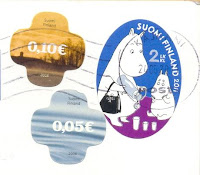
Cate from Austin, Texas sent me this nice card. The Rambler Rebel was an automobile produced by the American Motors Corporation (AMC) of Kenosh, Wisconsin from 1957–60, and again in 1966 and 1967. The Rambler Rebel debuted as a special model in the Rambler line showcasing AMC's big new V8 engine for the 1957 model year. It became the first factory-produced lightweight muscle car.
The Rebel name reappeared in the 1966 model year on a top-of-the-line Rambler Classic model. For the 1967 model year, AMC's entire intermediate line took the Rebel name. American Motors dropped the historic "Rambler" marque to become the AMC Rebel in 1968.
The stamps on this card are also very impressive. William Hart and Gene Autry were two very important actors in Wild West movies.
William Surrey Hart (December 6, 1864 – June 23, 1946) was an American silent film actor, screenwriter, director and producer. In 1917 Hart accepted a lucrative offer from Adolph Zukor to join Famous Players-Lasky, which merged into Paramount Pictures. In the films Hart began to ride a brown and white pinto he called
Fritz. Fritz was the forerunner of later famous movie horses known by their own name, i.e., horses like Tom Mix's
Tony, Roy Rogers's
Trigger and Clayton Moore's
Silver, etc. Hart was now making feature films exclusively, and films like
Square Deal Sanderson and
The Toll Gate were popular with fans. For his contribution to the motion picture industry, William S. Hart has a star on the Hollywood Walk of Fame at 6363 Hollywood Blvd. In 1975, he was inducted into the Western Performers Hall of Fame at the National Cowboy & Western Heritage Museum in Oklahoma City, Oklahoma. On November 10, 1962, Hart was honored posthumously in an episode of the short-lived
The Roy Rogers and Dale Evans Show, a western variety program on ABC.
Orvon Grover Autry (September 29, 1907 – October 2, 1998), better known as
Gene Autry, was an American performer who gained fame as The Singing Cowboy on the radio, in movies and on television for more than three decades beginning in the 1930s. Autry was also owner of the Los Angeles/California Angels Major League Baseball team from 1961 to 1997, a television station and several radio stations in Southern California. Although his signature song was "Back in the Saddle Again", Autry is best known today for his Christmas holiday songs, "Here Comes Santa Claus" (which he wrote), "Frosty the Snowman", and his biggest hit, "Rudolph the Red-Nosed Reindeer". He is a member of both the Country Music and Nashville Songwriters halls of fame, and is the only celebrity to have five stars on the Hollywood Walk of Fame.









































